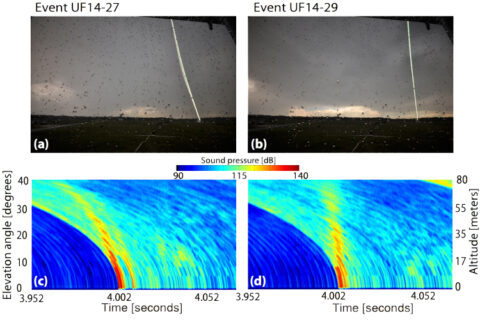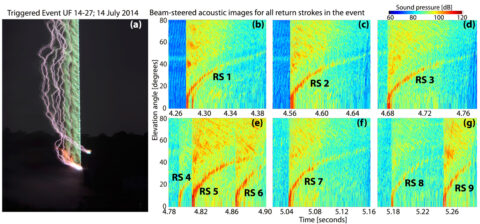A rainy and windy midsummer Monday in north Florida was a good day to catch an artificially triggered lightning bolt. It also turned out to be the perfect day to image thunder for the first time by visually capturing the sound waves created by the bolt.
The imaged thunder “provides new tools to further understand the origins of thunder and the energetics of the lightning channel.”
Although the physics behind lightning strikes remains poorly understood, imaging the acoustic signature of thunder “provides new tools to further understand the origins of thunder and the energetics of the lightning channel,” explained Maher Dayeh, a research scientist in the space science and engineering division of the Southwest Research Institute in San Antonio, Texas. Dayeh, who presented his research earlier this month at the 2015 Joint Assembly in Montreal, Canada, provided insight into the research in an interview with Eos.
“Literally seeing what we hear” is the most exciting part of the research, Dayeh told Eos. “It is amazing to pinpoint the acoustic sources along the lightning channel,” he said, referring to the irregular path along which a lightning discharge occurs.
“Every person perceives thunder differently, since it all depends on how far you are from the lightning channel. Close to it, the sound is sharper and louder. Far away, you hear long-lasting rumbles. This work provides a better idea on where sound comes from.”
Pulling Off the Experiment

Dayeh conducted the research with help from a rocket with a grounded copper wire launched on 14 July 2014 into thunderclouds above the International Center for Lightning Research and Testing (ICLRT) in Gainesville, Fla. The center is jointly operated by the University of Florida and the Florida Institute of Technology.
To “image” the sound, an array of 15 microphones—laid out along the ground 95 meters from the rocket launch pad—served as an “acoustic camera” to analyze the bolt. Dayeh said that the original constructed image looked less like thunder and more like a “wiggly and colorful” painting. However, at higher-frequency bands of sound, the image showed a distinct signature of thunder generated by a lightning strike, seen in the image to the right.
Resolving Pieces of Lightning
Previously, scientists typically reconstructed a lightning channel using just the sound of thunder. The technique usually involves triangulation of three or more microphones spread around the lightning source, Dayeh said. Although the recorded signals could be traced back to their source locations, no information could be inferred about the loudness along the channel, individual return strokes, or the full frequency content of the event, he explained.

Now the new technique could help reveal many traits previously unknown about lightning. ICLRT director of operations Doug Jordan and his team triggered the lightning and set up the microphones for Dayeh’s experiment. He noted that although artificially triggered lightning differs from natural lightning at the beginning of a strike, subsequent portions are “a good proxy” for studying natural lightning.
Before, “nobody had been able to have the processing and the data to actually be close enough to things that they could resolve various pieces of lightning. So we were pleased with that, that they could even do it,” Jordan said.
Lightning Studies: Still in Infancy
Joseph Dwyer, a professor at the University of New Hampshire, Durham, and a leading expert on lightning, was surprised that the experiment by Dayeh, who is his Ph.D. student, actually worked.
Producing an image “that you can recognize and say ‘Wow, I can actually see the lightning there in sound’…it’s pretty cool.”
“His is one of those things that seemed like a good idea, but you never know until you actually try it,” Dwyer told Eos. “You know, you’ve got microphones sitting outside. This is a thunderstorm. It’s windy. It’s rainy. There’s a lot going on. Plus you have lightning nearby, which can cause lots of problems if you have sensitive electrical equipment. So getting it all to actually work in practice was quite a challenge.”
Overcoming these challenges and then producing an image “that you can recognize and say ‘Wow, I can actually see the lightning there in sound’—which is like [what] a bat would do or a dolphin—it’s pretty cool,” he continued.
This new tool for studying lightning “shows the infancy of the field,” Dwyer said. “Here, in 2015, we’re just now getting around to making the first acoustic images of lightning.”
“We don’t understand how it gets started up inside thunderstorms,” he said. Plus, “we don’t understand very well how it propagates. And we don’t understand how it strikes things on the ground.”
New advances in the study of lightning can lead to important societal benefits, Dwyer explained. Lightning kills people and causes property damage, but it is a fact of life that people accept and get used to, he added.
However, its frequent occurrence is no reason for complacency, Dwyer said. “Suppose just randomly,” he continued, “every afternoon pianos fell from the sky and crashed to the ground. You would say, ‘Hey, somebody’s got to do something about this.’ Right? ‘Where’s all the research money to stop these pianos falling from the sky or at least predict where they’re going?’”
“There are at least four million lightning strikes a day to the planet,” Dwyer said. “We know very little about how it actually works.”
—Randy Showstack, Staff Writer
Citation: Showstack, R. (2015), Experiment Captures First Image of Thunder, Eos, 96, doi:10.1029/2015EO029823. Published on 19 May 2015.
Text © 2015. The authors. CC BY-NC 3.0
Except where otherwise noted, images are subject to copyright. Any reuse without express permission from the copyright owner is prohibited.

